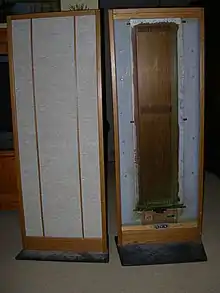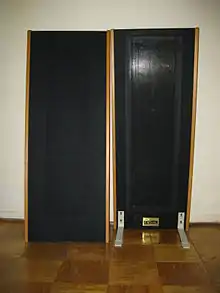Magnepan
Magnepan is a private high-end audio loudspeaker manufacturer in White Bear Lake, Minnesota, United States. Their loudspeaker technology was conceived and implemented by engineer Jim Winey in 1969.

Overview
Magnepan's speaker design, sold under the brand name Magneplanar (often referred to as "Maggies"), differs from that of conventional speakers in relying not on cones mounted in an enclosure, but on a planar driver system mounted in a panel. A Magneplanar's reproducing mechanism (magnetostatic loudspeaker) comprises thin conductive wires and or foil strips attached to a thin sheet of Mylar residing in a magnetic field created by a vertical array of permanent strip magnets. When an electric signal is applied to the conductors, the resultant electric current moving through the magnetic field applies a force to the wires or tape, moving the Mylar film sheet, which projects sound as a dipole. In principle, this approach relies on the same concept as a voice coil-driven cone speaker, but in a Magneplanar speaker the "voice coils" are attached (glued) directly to the radiating surface. Since the force is applied only to the voice coil in a cone speaker, there are distortion modes called cone breakup; in the magneplanar speakers the force is applied much more evenly over the radiating surface, resulting in fewer distortion modes.

Sound is projected from both the front and back of the radiating surface. The sound from the back of the speaker is reflected from the front wall of the listening area. This is said to effectively enhance the soundstage – the sense of space and realism – of the speaker. The Magneplanar design, using a passive magnet array, is not a unique loudspeaker implementation, although it was the first of its type. Eminent Technology, Analysis Audio, and others also employ passive magnet designs. Broadly, these are classed as planar-magnetic speakers.[1]
There are other speaker designs similar to the Magneplanar. Martin-Logan and Quad Electroacoustics, among others, make electrostatic loudspeakers, which are another variation on the dipole model. Electrostatic speakers operate on a somewhat different principle. While the voice coils in the Magneplanar are conductive wires or foil strips mounted on a sheet of Mylar film, electrostatic speakers suspend a charged conductive film between two grids (stators), which move the film. One disadvantage of both designs is that a very large panel is required to produce deep bass. Magnepan has addressed this by the physical size of the speakers – a physically large radiating surface produces more bass. Martin-Logan has addressed the bass problem by mounting a conventional cone bass driver in a separate section of the speaker chassis, generally resulting in a physically smaller speaker than the Magneplanar.
Technology
Magnepan has used several different technologies in constructing their magnetostatic speakers. All Magnepan speakers are based on flexible ferrite magnet strips (like refrigerator magnets), 0.060" (1.5 mm) thick, typically cut to either 1/4" (6 mm) wide (mid-bass) or 1/8" (3 mm) wide (tweeters) and more or less the length of the speaker. The magnets are glued to a piece of custom perforated 20-gauge (1 mm) steel sheet. The steel supports the magnets and also completes the magnetic circuit on the back of the magnets, resulting in about a 25% stronger magnetic field in front of the magnets. Mylar film, 0.0005" (12.5 μm) thick, is suspended in front of the magnet structure about 1/16" (1.6 mm) away from the magnets. Aluminum wires or film are then glued to the mylar. Only aluminum was used: copper has two-thirds the resistance of aluminum, which would make the speakers either much larger or much more difficult to drive. Very few amplifiers can handle 2.7-ohm speakers. Older Magnepans used aluminum magnet wire, thin 31 gauge (0.0089", 0.23 mm) for the tweeters and thicker 22 gauge (0.0253", 0.64 mm) for the mid-bass. The wire is glued to the mylar with 3M 77 spray adhesive, then sealed with 3M Fastbond 30NF (Magnepan used to use Milloxane to seal, but no more).
Newer Magnepans use 30 μm (0.0012") thick 1/8" (3 mm) wide aluminum tape instead of wire. When the aluminum tape is used instead of wires, Magnepan calls the speakers "Quasi-Ribbons".[2] Using the aluminum tape spreads out the driving force on the mylar speaker diaphragm, resulting in noticeably lower distortion.
Magnepan ribbons are constructed with a strip of aluminum roughly 5 μm (0.0002") thick, 1/4" (3 mm) wide, 60" (1.5 m) long. The aluminum is corrugated – the pleats help keep the ribbon from flexing between the magnets. Before corrugating the ribbon it's more like 80" (2 m) long. The aluminum is suspended between two ferrite magnets, about 3⁄8 in × 1⁄2 in (9.5 mm × 12.7 mm) in cross-section. The magnets are attached to a 1/8" (3 mm) thick piece of formed and perforated steel, which both holds the magnets in place and also completes the magnetic circuit, resulting in about a 40% stronger magnetic field in the magnet gap.[3]
The most frequently cited disadvantages of Magnepan's overall design are relatively low efficiency and, given the absence of an enclosure, difficulty in reproducing very low bass frequencies. Because of the low resistance (4 ohms) and low sensitivity (86 dB), it requires a surprising amount of current to drive the Magnepans to moderately loud listening levels. Many inexpensive receivers simply do not have the required current capacity, so they go into various distortion modes, including crossover distortion, clipping and slew limiting, with the result that the Magnepans may not sound very good. If the amplifier starts clipping, it could destroy the ribbon or treble wiring. Driving the Magnepans with a 100-watt or better high-current amplifier will result in much better sound. Generally, the amplifier should put out double the power into 4 ohms that it does into 8 ohms; if the specification is for less than double, then the power supply and/or output stage of the amplifier will most likely not be sufficient to obtain best sound from the Magnepans. Many suitable modern and vintage amplifiers can do this, but it depends on their design.
Models
Originally Magnepan sold the MG and the Tympani series. The Tympani series has been discontinued for several decades and is replaced by the 20.7 and 30.7 speakers. The MG series has been produced continuously, but the "MG" has been dropped from the name; thus the MG-I is now the 1.7; the MG-II is now the (discontinued) 2.7, and the MG-III is now the 3.7. Magnepan also produced a small, relatively inexpensive speaker, the SMG, which became the MMG and is now called the LRS. The Tympanis and MG speakers were all made from wire-on-mylar; the speakers with no "MG" in the name are all made from aluminum foil on mylar ("Quasi-Ribbon"). The MG-III, 3.7, Tympani IV, 20.7 and 30.7 all include Magnepan's ribbon driver and thus produce sound up to 40 kHz. The other speakers do not include a true ribbon and therefore produce sound only up to about 18–25 kHz.
All Magnepans are 4-ohm speakers, with sensitivity of 86 dB at 500 Hz, 2.83 V.
| Model | Technology | Freq. range | Size (inches) | Production years | Price 2020 |
|---|---|---|---|---|---|
| Magneplanar LRS [4] | 2-Way / Quasi-Ribbon | 50 Hz – 20 kHz | 14.5 × 48 × 1.25 | 2019–present | $650 |
| Magneplanar .7i [5] | 2-Way / Quasi-Ribbon | 45 Hz – 20 kHz | 15 × 54 × 1.25 | 2010–present | $1400 |
| Magneplanar 1.7i [6] | 3-Way / Quasi-Ribbon | 40 Hz – 24 kHz | 19 × 65 × 2 | 2010–present | $2000 |
| Magneplanar 2.7i | 3-Way / Quasi-Ribbon | 40 Hz – 24 kHz | 22 × 71 × 2 | 2000–2013 | $1500 used |
| Magneplanar 3.7i [7] | 3-Way / Ribbon Tweeter + Quasi-Ribbon | 35 Hz – 40 kHz | 24 × 71 × 1.6 | 2013–present | $6000 |
| Magneplanar 20.7 [8] | 3-Way / Ribbon Tweeter + Quasi-Ribbon | 25 Hz – 40 kHz | 29 × 79 × 2 | 2011–present | $14,000 |
| Magneplanar 30.7 [9] | 4-Way / Ribbon Tweeter + Quasi-Ribbon | 20 Hz – 40 kHz | 29 × 79 × 2 + 16 × 79 × 2 | 2017–present | $30,000 |
| Magneplanar SMG / MMG | 2-Way / Planar Magnetic | 50 Hz – 18 kHz | 14.5 × 48 × 1.6 | 1990–2018 | $300 used |
| Magneplanar MG-I | 2-Way / Planar Magnetic | 50 Hz – 18 kHz | 22 × 60 × 1.6 | 1972–1999 | $300 used |
| Magneplanar MG-II | 2-Way / Planar Magnetic | 40 Hz – 18 kHz | 22 × 71 × 1.6 | 1980–1999 | $400 used |
| Magneplanar MG-III | 3-Way / Ribbon Tweeter + Planar Magnetic | 37 Hz – 40 kHz | 23 × 72 × 2 | 1983–2000 | $600 used |
| Magneplanar Tympani I | 3-Way / Planar Magnetic | 40 Hz – 20 kHz | 48 × 72 × 1 | 1973–1978 | $2000 used |
| Magneplanar Tympani III | 3-Way / Planar Magnetic | 35 Hz – 25 kHz | 64 × 72 × 1 | 1976–1980 | $2000 used |
| Magneplanar Tympani IV | 3-Way / Ribbon Tweeter + Planar Magnetic | 30 Hz – 40 kHz | 48 × 72 × 1 | 1980–1999 | $2500 used |
Interviews
- Jim Winey: Maggie's Man in Stereophile, January 2003
References
- Fantel, Hans (24 March 1985). "Sound; a Flat Loudspeaker Delivers Well-Rounded Music". The New York Times. Retrieved 22 February 2019.
- Magnepan Quasi Ribbon cutaway picture.
- Magnepan Ribbon cutaway picture.
- Guttenberg, Steve. "Are you ready for bona-fide high-end speakers for $650 a pair?". CNet. Retrieved March 30, 2019.
- Guttenberg, Steve. "The radically different Magnepan .7 speakers". CNet. Retrieved May 16, 2015.
- Jeffries, Maurice. "The Wonderful Magneplanar 1.7i Loudspeakers". positive-feedback. Retrieved 26 July 2016.
- Soo, Constantine. "Magnepan 3.7i full-range ribbon/quasi-ribbon panel". DaGoGo. Retrieved 1 May 2016.
- Howard, Keith. "Magnepan Magneplanar 20.7 loudspeaker". hifinews. Retrieved Apr 1, 2018.
- Martens, Chris. "Magnepan 30.7 four‑panel dipolar planar loudspeaker system". Hi-Fi+. Retrieved 17 February 2019.